Menudo (soup)
In Mexican cuisine, Menudo, also known as pancita ([little] gut or [little] stomach, from Spanish: Panza; "Gut/Stomach") or mole de panza ("stomach sauce"), is a traditional Mexican soup, made with cow's stomach (tripe) in broth with a red chili pepper base. It shares a name with a stew from the Philippines made with pork and pork liver.
| Place of origin | Mexico |
|---|---|
| Main ingredients | Beef tripe (cow stomach), broth, hominy, lime, onions, cilantro, oregano, red chili peppers |
| Variations | Menudo colorado (made with chili rather than broth): menudo blanco (made without red chili peppers) |
Hominy, lime, onions, and oregano are used to season the broth.
Cultural significance
Menudo is traditionally prepared by the entire family, and often serves as an occasion for social interactions such as after wedding receptions where the families of the groom and bride go to either family's house to enjoy a bowl of menudo before and after the ceremony. It is also a purported remedy for recovery from alcoholic consumption.[1]
Menudo is time intensive to prepare, as the tripe takes hours to cook. It includes many ingredients and side dishes (such as salsa), and garnished with chopped onions, chiles, cilantro, and often with lime juice; it is often prepared communally and eaten at a feast. Documents from the Works Progress Administration indicate that in the 1930s, among migrant workers in Arizona, menudo parties were held regularly to celebrate births, Christmas, and other occasions.[2]
Preparation
Four to seven hours to cook are required. Those who sell beef tripe offer a version of this meat which has been previously processed by boiling it in hot water, which reduces cooking time by hours. In its simplest form, beef tripe is rinsed then boiled for three hours in a large pot with half an onion to remove the strong odor of the tripe. It is then removed from the pot, discarding the onion half, and allowed to cool before being cut into strips, or occasionally diced. The water is removed and discarded, then the tripe is put back into the pot and fresh water, oregano, red chili paste or powder, lime/lemon juice, hominy, and salt are added and boiled.
Menudo is typically served with chopped raw onions, oregano, diced chiles (usually serrano), and lemon or lime segments along with corn or flour tortillas.
Menudo almost always includes tripe, and some versions of the dish in Mexico also include honeycomb and "librillo" beef meat along with the beef feet and tendons. Versions of the dish which include meats other than tripe has a much longer cooking time. Pigs feet are also used in northern-style menudo, for example in Chihuahua. The feet and tendons are boiled first at low to medium heat for about three hours. After the first three hours, the tripe should be added along with salt, an onion cut in half, and one or two heads of garlic. Red menudo has the addition of Guajillo chili paste. The menudo is allowed to continue boiling for an additional three hours while covered. Once it is almost done, the hominy is added.
Regional variations
There are a number of regional variations on menudo. In northern Mexico, typically hominy is added. In northwest states such as Sinaloa and Sonora usually only the blanco, or white, variation is seen; menudo blanco is the same dish, with the difference that red pepper is not added (though jalapeño or chopped green chilies may be added to the broth to replace the spice found in the red version), thus giving the broth a clear or white color. Adding patas (beef or pigs feet) to the stew is popular in the US but not universal. In some areas of central Mexico, "menudo" refers to a stew of sheep stomach, "pancitas" stew of beef tongue. In south-western Mexico (in and around the Distrito Federal, Morelos, and Guerrero) it is called "panza" or "panza guisada". The red variation is usually seen in Chihuahua, the northern state adjoining Texas. It is also usual to use only yellow hominy in menudo in the Texas region. A similar stew made with more easily cooked meat is pozole. Some variations of menudo substitute garbanzo beans instead of hominy.
Menudo in the U.S.
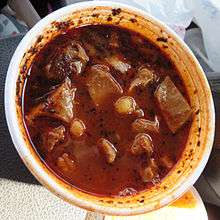
In the United States, since the mid-20th century, prepared menudo has been common in food stores and restaurants in cosmopolitan areas and in other areas with a significant Mexican population. Restaurants often feature it as a special on Saturday and Sunday,[3] and the folklore belief that menudo will alleviate some of the symptoms of a hangover is widely held.[4]
An annual Menudo Festival is held in Santa Maria, California. In 2009, more than 2,000 people attended and 13 restaurants competed for prizes in three categories. The festival is organized by the National Latino Peace Officers Association of Northern Santa Barbara County and the money raised goes toward scholarships for local students.[5]
Since 1996, the Menudo Bowl is an annual event in Laredo, Texas. In 2019 there were over 30 teams participating to make the best menudo. The event is organized by Laredo Crime Stoppers, with teams conformed by public officials, law enforcement, media representatives, and members of the community. The event is attended by people from both sides of the border.[6]
Gallery
- Menudo variations
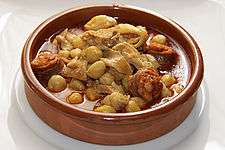 Menudo with garbanzo beans and chorizo sausage
Menudo with garbanzo beans and chorizo sausage- Menudo blanco
 Menudo en Cadiz
Menudo en Cadiz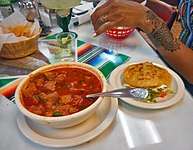 Mondongo (menudo) soup and gordita
Mondongo (menudo) soup and gordita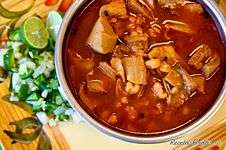 Menudo rojo (Red menudo)
Menudo rojo (Red menudo)
See also
- Flaki
- İşkembe çorbası
- Sopa de mondongo
- Tripes à la mode de Caen
- List of Mexican dishes
- List of soups
References
- Arellano, Gustavo (2007). Ask a Mexican!. mex: Simon and Schuster. pp. 148–49. ISBN 978-1-4165-4002-1.
- Kurlansky, Mark (2009). The food of a younger land: a portrait of American food; Before the national highway system, before chain restaurants, and before frozen food, when the nation's food was seasonal, regional, and traditional: from the lost WPA files. mexששמםיה: Penguin. pp. 353–56. ISBN 978-1-59448-865-8.
- "Where do you go for Menudo on Sunday in LA?". Chowhound. Retrieved 24 May 2015.
- Gonzalez, Ray (1992). "Hangover Cure". Lapham's Quarterly. Retrieved 2013-05-05.
- Staff report. "Annual festival celebrates Mexican Independence Day". Santa Maria Times. Retrieved 24 May 2015.
- Sanchez, Ashley; Times, LMTonline com / Laredo Morning (2019-01-20). "2019 Menudo Bowl winners announced". Laredo Morning Times. Retrieved 2020-01-09.

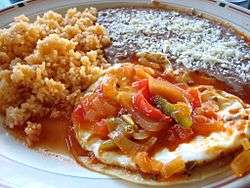
.jpg)
